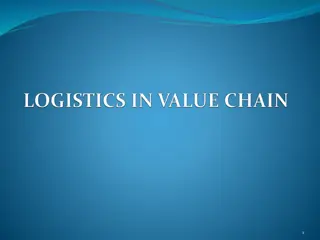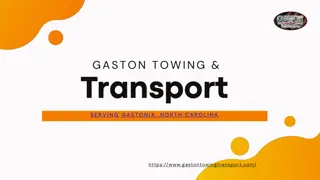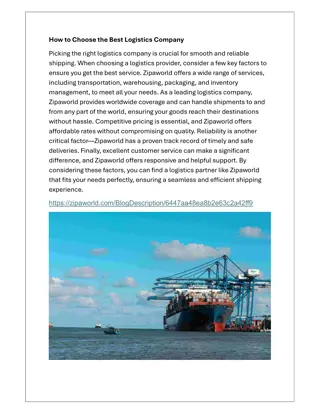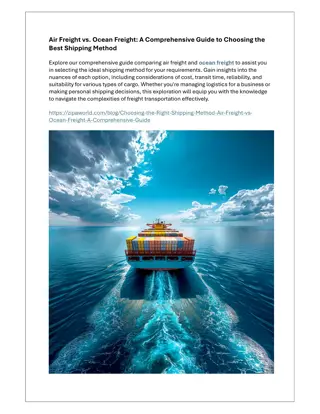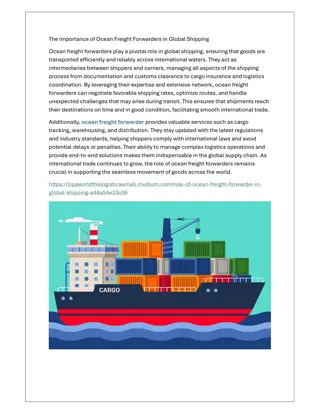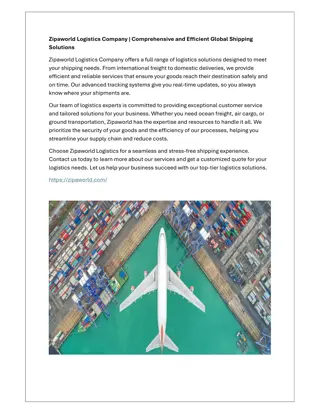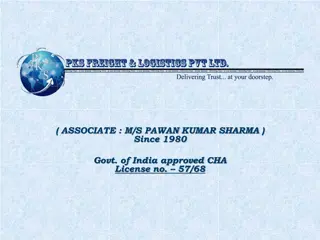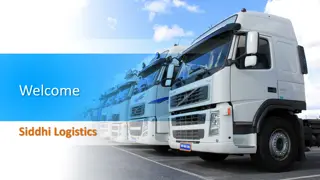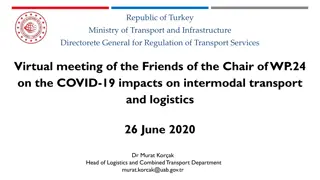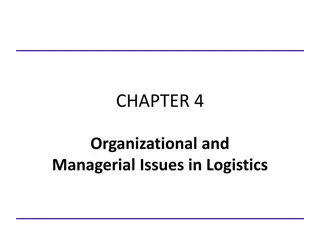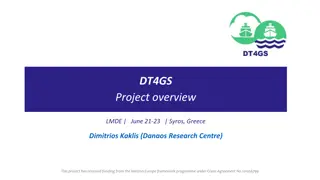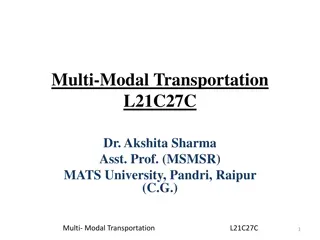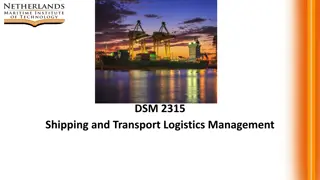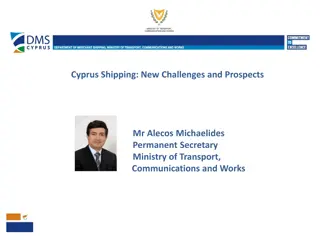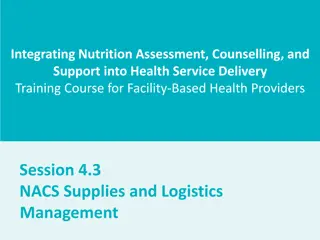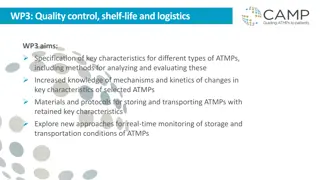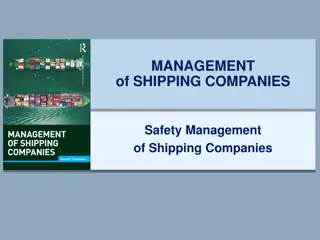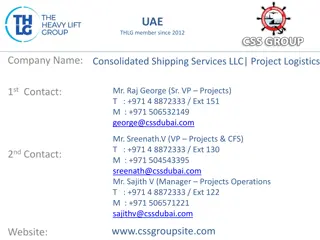Essential Safety Measures in Shipping and Transport Logistics Management
Understanding and implementing rules of the road, navigational safety requirements, and safety systems onboard are crucial for ensuring safe vessel operations. The Rules of the Road outline key directives to prevent collisions, while navigational safety and onboard safety systems focus on equipment requirements, maintenance, and crew training essential for safe navigation. Compliance with the International Safety Management (ISM) Code enhances safety practices onboard ships.
Download Presentation

Please find below an Image/Link to download the presentation.
The content on the website is provided AS IS for your information and personal use only. It may not be sold, licensed, or shared on other websites without obtaining consent from the author. Download presentation by click this link. If you encounter any issues during the download, it is possible that the publisher has removed the file from their server.
E N D
Presentation Transcript
DSM 2315 Shipping and Transport Logistics Management
5. Introduction to Vessel Operation 5.1 Introduction to rules of the roads
Introduction to the Rules Of The Roads Also called Navigation Rules The basic laws governing the steering or sailing of a vessel. Rules of the Road define the roles and responsibilities of vessel operators. If all operators obeyed these rules, most accidents could be avoided. One of the reasons the Rules of the Road exist is to keep vessels from colliding with each other and with other objects. Since collisions are the number one type of accident on the water, Rules of the Road should be remembered.
Rules Of The Roads Post a lookout. Designate someone to watch for dangers that may come from any direction. Maintain a safety speed. Except where speed is restricted by regulation or the waterway is marked by a No Wake or Slow Speed . And, you must judge safe speed for yourself, taking into account visibility, vessel traffic, your boat s ability to maneuver, and the weather conditions. Avoid a collision. The Rules of the Road include the actions to take when encountering another vessel on the water. Some of the most common situations you may encounter are: overtaking, meeting head on, and crossing the bow of another vessel. In each case, the boat designated as the give-way vessel is required to yield on the other boat, while the boat designated as the stand-on vessel should maintain its course and speed.
Navigational Safety Ship requirements relating to navigational safety and equipment help to ensure that ships navigate and operate safely, avoid collisions and groundings, and that navigational errors are minimized. There operational requirements to enhance navigational safety. are navigation equipment carriage requirements and
Safety Systems On Board Safety on board the ships is an important issue. Safety is Paramount The ship should be of good design, well maintained, and in seaworthy condition with sufficient stability, watertight and weather tight and properly equipped. Prevention through recognition, rectification and avoidance of unsafe actions and/or situations at all the times and at all places on board by all personnel and passengers are of utmost importance.
Safety Systems On Board (cont) Since July 2002, all ships (and their ashore offices) have to be certified under the International Safety Management Code (ISM Code) and the crew has to work in accordance with the Safety Management System (SMS). The SMS is a set of rules, describing in detail how to use safety gear. Course and regular drills are held in order to ensure that the crew is safety-conscious. The crew is trained to use the right equipment in case of emergency. Regulations concerning safety on ships are formulated by the IMO Department called the Marine Safety Committee (MSC), responsible for the SOLAS Convention (Convention for Safety of Life At Sea).
Life Saving Apparatus Lifeboats have to be installed on each side of the ship, each capable of accommodating everybody on board. Every life boat must have a diesel engine, started by batteries and backed up by manual start. Life rafts: Inflatable life rafts are located on each side for the whole complement. A normal cargo ship with lifeboats has the throw overboard type raft which needs to be connected to the ship by a line and sea fastened with a band and closed by a hydrostatic release. Life jackets are provided for everyone on board. They must have a light and whistle. They are usually stored in the cabins, but sometimes in boxes near the lifeboats.
Life Saving Apparatus (cont) A number of life buoys, depending on the ship s length are positioned around the vessel and hooked on the handrails. As of July 2006, everybody on board a cargo ship, including bulk carriers, has to have an immersion suit. An immersion suit has to be worn together with a life jacket. The insulating quality of the immersion suits has to be such that the body temperature does not drop more than 2 degree Celsius after 6 hours in water with a temperature between 0 and 2 degree Celsius. Work professionally with all equipment, the ship s crew needs to be educated and everyone must have Certificate of Competency. This certificate can only be obtained when the individual is in possession of the proper diplomas, sufficient sea service and a number of certificates obtained after fulfilling certain safety courses.
Cargo Safety / Cargo Loading Stowing and securing cargo on board Know the forces that will be exerted on your cargo Establish if climate conditions will change during your product s journey Plan your cargo stowage Inspect the container before loading Upon loading ensure that the point of gravity of the cargo is at or near the longitudinal center line of the transport unit
Cargo Safety / Cargo Loading (cont) Prevent sliding & tipping of the cargo by proper blocking & bracing the cargo using polyester strapping Use friction increasing anti-slip mats to prevent cargo movement Prevent fall out at doorway on arrival at destination Do not assume that heavy cargo do not move Make sure that your cargo securers are trained in line with the latest IMO/ILO/UN ECE Guidelines
5. Introduction to Vessel Operation 5.2 Navigation aids
Navigation Aids Typically aid navigation is an external structure designed to help a ship or any other marine craft to make way through water. This is essentially a structure outside the ship which helps the ship in safe journey. The purpose of typical aid navigation is everything from guiding a ship in the right direction to warning about an imminent danger. It can also be used by a vessel to point out its exact position in the water or to warn other ships about its location in case it is stuck in some situation such as failed propellers, ground, engine failure, etc. International regulations strive to set standards for a navaid like buoys (color, lighting, positioning) which can be understood by sailors all over the world to prevent any confusions and save lots of lives.
Navigational Aids include: Light house Buoys Beacons Mooring points Nautical charts
Navigation Aids On Board Ships Gyrocompass Radar Direction Finder Radio Direction Finding works by comparing the signal strength of a directional antenna pointing in different directions. Echo Sounding Device Position Fixing Device
Echo-Sounding Determining the location of something by measuring the time it takes for an echo to return from it. It is also used to measure the depth of water.
Navigation Navigation refers to study that focuses on the process of monitoring and controlling the movement of a vessel / craft / vehicle from one place to another. Maritime navigation is an art and science. The science of navigation (knowledge) can be taught but the art of navigation (skill) must be developed from experience. A good navigator constantly thinks strategically, operationally and tactically. The navigator determines his ship s position in the sea after obtaining the relevant information from all the sources and evaluating these information. He commitments, and predetermined dead reckoning position. compares the ship s position with voyage plan, operational
Navigation (cont) A good navigator anticipates dangerous situations well before they arise, and always stays ahead of vessel and ready for navigational emergencies at any time. He is increasingly a manager of various resources electronic, mechanic and human. The navigator uses the methods and techniques best suited to the vessel, equipment and conditions at hand. Many methods of navigation has been evolving over the years but the navigators should use the best method. Each method has its advantages and disadvantages. None is effective at all situation.
Commonly recognized methods Navigation Dead reckoning (DR) Piloting Celestial navigation Radio navigation Radar navigation
Dead Reckoning (DR) DR determines position by advancing a known position for courses and distance. It is a process of calculating one s current position by using a previously determined position, or fix, and advancing that position based upon known or estimated speeds over elapsed time and course. (see diagram) The position is so called Dead Reckoning Position. Only course and speed determine the position. Current effects and steering results in estimated position.
Piloting This involves navigating in a restricted waters with frequent or constant determination of position relative to nearby geographic and hydrographic features.
Celestial Navigation It involves a reducing celestial measurements taken with extent to linear position using calculators or computer programmes or by hand with almanac and tables or using spherical trigonometry.
Radio Navigation It uses radio waves to determine position through a variety of electronic devices.
Radar Navigation It uses radar to determine the distances from or bearing of objects where position is known. This process is separated from radar s use in collision avoidance.
Satellite Navigation This system uses radio signals from satellites for determining position.
Accuracy of Navigation Systems VOR - VHF omnidirectional range DME - Distance measuring equipment
Navigation Limitations Electronic Systems and integrated bridge concepts are driving navigation system planning. Integrated system take inputs from various ship sensors, electronically and automatically chart the position, and provide control signals required to maintain a vessel on a preset course. The navigator now becomes a system manager, choosing system preset, integrating system output, and monitoring vessel response. With the advent of automated position fixing and electronic charts, modern navigation is almost completely an electronic process. The mariner is always tempted to use electronic system but the systems is always subjected to failures. Proficiency in conventional piloting and celestial navigation remains essential.
Phases of Navigation Four distinct phases define navigation processes: Inland Waterway Phase Harbour/Harbour Approach Phase Coastal Phase Ocean Phase
Phases of Navigation (cont) Inland Waterway Phase This refers to piloting in narrow canals, channels, rivers and estuaries. Harbour/Harbour Approach Phase This refers to navigation to a harbor entrance through bays and sounds, and negotiating harbor approach channel. Coastal Phase This involves navigation within 50 miles of the coast or in shore of the 200 meter depth contour. Ocean Phase This refers to navigation outside the coastal area in an open area.
5. Introduction to Vessel Operation 5.3 Berthing, anchoring and mooring arrangements.
Berthing Berthing means bringing in a vessel alongside. A berth is a sea-room with sufficient space to maneuver. Dock - an area of water in a port that can be closed off and that is used for putting goods onto and taking them off ships or repairing ships. Video
Anchoring Anchoring means mooring a ship to the sea bottom which anchor- secured firmly in position. Video
Mooring Mooring means anchoring or making fast to shore/dock to the wharf. The securing confining a vessel in a particular station, as by cables, wires, chain or ropes. A vessel is moored in safely ! A mooring is referred to any permanent structures to which a vessel may be secured. I.e. quay, wharves, jetties, anchor buoys, etc. Video
5. Introduction to Vessel Operation 5.4 Watch keeping arrangement
Watch Keeping Arrangement The master is to ensure watch keeping arrangements are adequate for maintaining a safe navigation watch. The officers responsible for navigating the ship safely when on duty with particular concern with collision and maintain a continuous state of vegilence. The main of watch keeping is to protect the marine environment should be aware of the operational / accidental pollution of marine environment
Types of Watch-Keeping Engine Navigation Security Communication
More Information on Watchkeeping Recommendation On Basic Principles And Operational Guidance Relating To Navigational Watchkeeping http://www.imo.org/blast/blastDataHelper.asp?data_id=27382&filen ame=A285%28VIII%29.pdf International Convention on Standards of Training, Certification and Watchkeeping for Seafarers, 1978 http://www.imo.org/OurWork/HumanElement/TrainingCertification/ Pages/STCW-Convention.aspx
5. Introduction to Vessel Operation 5.5 Crew composition and functions
Ship Organisation Head by a master [A sea captain (also called a captain or a master or a shipmaster) is a licensed mariner in ultimate command of the vessel.] Skipper - It is also more frequently used than captain with privately owned noncommercial or semi-commercial vessels, such as small yachts and other recreational boats, mostly in cases where the person in command of the boat may not be a licensed or professional captain, suggesting the term is less formal.
Ship Organisation (cont) Comprised of 4 departments: Deck (Navigating Officer or Deck Officer) Navigating officer is responsible for safe navigation of the ship, and its cargo operations. Engineering (Marine Engineer or Engineering Officer) Marine engineer is responsible for the various systems (machinery) which propel and operate the ship. Radio Communication (Naval Architect) Naval architect is concerned with the hull, its construction, form, habitability and ability to endure its environment. Catering


